Physical Address
304 North Cardinal St.
Dorchester Center, MA 02124
Emergency clinicians often face the challenge of caring for agitated, uncooperative, combative, and violent patients who are unable to participate in their care, make rational health care decisions, and/or are a danger to themselves and others. Psychiatric illness, acute chemical intoxication or withdrawal, delirium, medical illness, uncontrolled rage, hypoxia, and rarely, central nervous system infection are causes of agitated or violent behavior in the emergency department (ED).
Patients more likely to exhibit severe uncontrolled agitation are those who abuse alcohol; sympathomimetic agents such as cocaine or methamphetamines or designer drugs such as ecstasy (MDMA), mephedrone, or methylone (bath salts); and hallucinogenic drugs such as phencyclidine (PCP). Patients can also experience toxicity after accidental and intentional ingestion of medications. Drug-associated delirium may be related to anticholinergic toxicity, serotonin syndrome, or intoxication with sympathomimetics. Alcohol withdrawal may progress to delirium tremens, a condition typified by excessive agitation and confusion.
Patients with agitated delirium are often the most difficult to manage and at high risk for significant morbidity and mortality. This is especially true for patients with excited delirium syndrome (ExDS), a variant of and the extreme form of agitated delirium (see later section on ExDS ). Causes of agitated delirium include manic-depressive disorder, psychosis, chronic schizophrenia, intoxication with sympathomimetics or anticholinergics, cocaine intoxication, alcohol or benzodiazepine withdrawal, hypoglycemia, the postictal state, or head trauma. Some causes are idiopathic, but many are due to a combination of underlying psychiatric illness and stimulant drugs or alcohol (or both). Because of the variety of causes, management of agitated and combative patients requires a systematic approach ( Fig. 69.1 ).
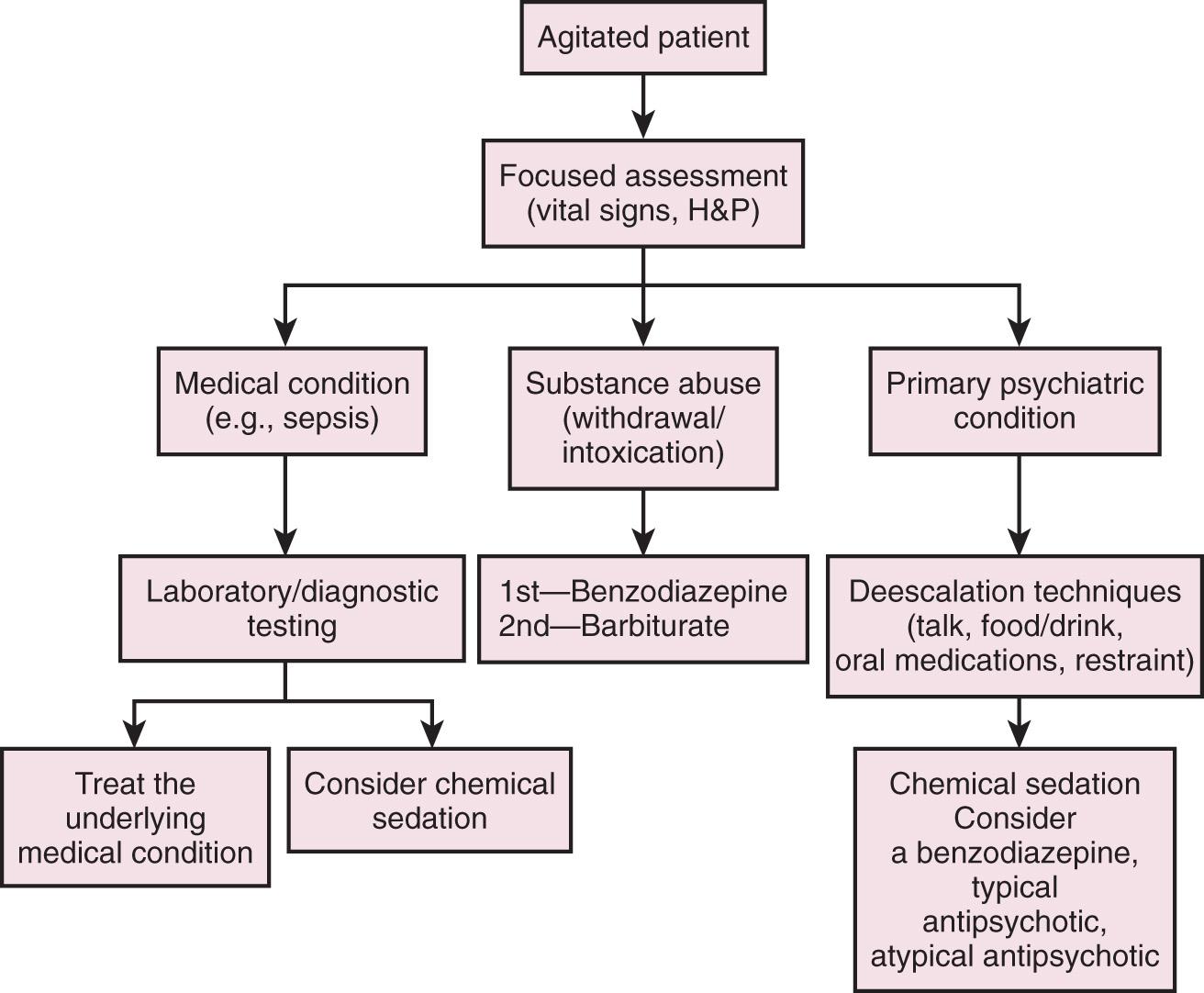
Schizophrenia, schizoaffective disorder, and the manic phase of bipolar disorder can all lead to an impaired perception of reality. Paranoid delusions, hallucinations, and hostile moods that can easily lead to severe agitation often develop in patients with these disorders.
Any medical condition that leads to brain dysfunction may also result in agitated, combative, or violent behavior ( Box 69.1 ). Well-documented examples include hypoglycemia, hypoxia, medication intoxication, encephalitis, meningitis, intracranial hemorrhage, thyrotoxicosis, traumatic brain injury, febrile illnesses in the elderly, and dementia.
Hypoglycemia
Hyperglycemia
Thyrotoxicosis, thyroid storm
Myxedema
Meningitis
Encephalitis
Sepsis
Urinary tract infection
Acute alcohol intoxication
Sympathomimetic intoxication
Anticholinergic intoxication
Delirium tremens
Alcohol withdrawal
Benzodiazepine withdrawal
Narcotic withdrawal
Intracranial hemorrhage
Diffuse axonal injury
Hypoxia
Low-flow states secondary to systemic hemorrhage
Hypoxia
Hypercapnia
Hyponatremia
Hypernatremia
Status epilepticus
Postictal states
Acute delirium
Subarachnoid hemorrhage
Cerebral vascular accident
It is essential to achieve control of an agitated patient as quickly as possible. Goals of management include preventing patients from harming themselves and others, identifying the underlying cause, and initiating medical treatment. Early intervention allows caregivers to implement appropriate monitoring, perform a physical examination, initiate diagnostic testing, and institute timely treatment. Successfully achieving these goals often necessitates physical and chemical restraint.
During the late 1980s and early 1990s, reports of restraint-associated deaths in psychiatric and extended care facilities led lawmakers to pass legislation establishing regulations for the use of restraint. Since then, the Joint Commission for Accreditation of Healthcare Organizations (TJC) and the Center for Medicare and Medicaid Services (CMS) have created standards governing the use of restraint in a variety of health care settings, including EDs and tertiary care facilities ( Box 69.2 ). The aforementioned standards allow the use of physical restraint for a limited period. A licensed practitioner must evaluate the patient and determine that less restrictive interventions have been ineffective and physical restraint is required to ensure the patient's well-being. The standards also include requirements for written policies and procedures governing the use of restraint that must address indications, staff training and education, patient assessment and reevaluation, appropriate documentation, and patient-focused issues such as maintaining dignity and respect. Hospitals and extended care facilities are required by law to report any death or adverse event related to the use of restraint.
Guidelines for assessing the patient
Criteria for applying restraint
Criteria for monitoring the patient and reassessing the need for restraint
Monitoring at least every 2 hours or sooner based on patient needs
Criteria for terminating restraint
Relevant orders for use
Results of patient monitoring
Reassessment
Significant changes in the patient's condition
TJC , The Joint Commission.
Some authors have advocated “restraint-free” environments in nursing homes, extended care facilities, and acute care hospitals. Although this concept is laudable, mandating a restraint-free ED is impractical and potentially dangerous. Clinicians should recognize the risks associated with restraining a patient; however, they should not be deterred from using either physical or chemical restraint when patients demonstrate dangerous behavior toward themselves or others. Indeed, the American College of Emergency Physicians (ACEP) recently revised and approved their policy statement in 2014 by supporting the careful and appropriate use of physical restraints or seclusion.
In September 2009, a task force of the ACEP published a multi-authored White Paper Report on ExDS. This was a landmark report because it legitimized a heretofore poorly defined serious medical scenario that was familiar to law enforcement, emergency medical services, and emergency physicians. In addition, it supported the aggressive and potentially lifesaving use of chemical sedation.
It was the consensus of the task force that ExDS is a unique syndrome that may be identified by the presence of a distinctive group of clinical and behavioral characteristics that can be recognized in the premortem state. ExDS, though potentially fatal, may be amenable to early therapeutic intervention in some cases.
The task force defined the existence of excited delirium as a true disease entity; described the signs, symptoms, and risk for death; and reviewed current and emerging methods of control and treatment. Before this report, agitated delirium and various poorly defined related terms were used to describe a serious form of agitated delirium that could culminate in death. Such deaths were often high-profile news events that inexplicably occurred in seemingly healthy young males and often involved interactions with seriously deranged and violent individuals and law enforcement officers.
The majority of affected individuals are young males. Features of ExDS include uncontrolled aggression and agitation, tremendous pain tolerance, tachypnea, tachycardia, sweating, tactile hyperthermia, pacing, grunting, noncompliance with police orders, unusual and untiring strength, being inappropriately clothed, extreme paranoia, and having an attraction to mirror or glass. Individuals are unable to engage in rational discussion or understand or deescalate their abnormal aggressive, violent, and threatening behavior. A common fatal scenario is characterized by a period of extreme delirium, increasing agitation, and inability to reason or comply with efforts to control their agitated state, followed by a struggle with law enforcement that involves vigorous physical restraint (choke holds, hog-tying, prone positioning, knee to the throat), and noxious chemicals. The actual role of physical restraint is unproven. The use of the TASER device (TASER International, Inc., Scottsdale, AZ) to control violent and markedly agitated individuals has been temporally related to death, but the role of this device in causing death is also unproven. Intervention may be followed by a sudden cessation of struggling that may herald death by cardiopulmonary arrest.
The exact cause of death in ExDS cannot be identified at autopsy. Death may be related to underlying but unknown pathology (such as cardiomyopathy, conduction abnormalities, and metabolic disturbances). Lack of complete prior medical information, especially underlying cardiac abnormalities, hampers ascertainment of the actual cause of death when only the autopsy results are interpreted. Unfortunately, law enforcement may be blamed for using excessive force when no autopsy proven cause of death is forthcoming.
Stimulant drug use, including cocaine, methamphetamine, and PCP, has a well-established association with ExDS and is usually implicated as being closely linked to if not causative of death from ExDS. Persons with psychiatric illnesses represent the second largest, but distinctly smaller cohort of ExDS cases. The combination of drugs, alcohol, and psychiatric illness is well recognized. Some deaths are temporally related to the application of a conducted electrical weapon (CEW; e.g., a TASER), but there are well-documented cases of ExDS-associated deaths with minimal restraint such as handcuffs without TASER use.
No definitive diagnostic tests are available for ExDS. Currently, it must be identified by clinical features, which renders it very difficult to ascertain the true incidence. Though not universally fatal, it is clear that a proportion of individuals with ExDS progress to cardiac arrest and death regardless of medical intervention.
Although the specific precipitants of fatal ExDS remain unclear, epidemiologic and clinical reports provide some understanding of the underlying pathophysiology. The clinical picture is one of an agitated and delirious state with severe autonomic dysregulation. When available, cardiac rhythm analysis demonstrates bradycardic asystole; ventricular dysrhythmias are rare and have occurred in only a single patient in one study. Severe acidosis and hyperthermia appear to play a prominent role in lethal ExDS-associated cardiovascular collapse. One potential cause is thought to be excessive central dopamine stimulation.
Based on the available evidence, it was the consensus of the task force that ExDS is a real syndrome of uncertain etiology. It was also the consensus of the panel that rapid and appropriate, albeit limited, physical restraint measures and immediate administration of benzodiazepines intravenously, ketamine intravenously, or midazolam intranasally may be lifesaving.
Importantly, insufficient data were available to the task force to determine whether fatal ExDS is preventable or whether there is a point of no return after which the patient will die regardless of advanced life support interventions.
Emergency clinicians need to be cognizant of the potential legal ramifications stemming from physically restraining patients. The risk for litigation may be mitigated by strict adherence to written institutional and departmental policies regarding the use of restraint and medications. Unfortunately, no one-size-fits-all protocol is realistic, and each case must be individualized by a clinician at the bedside, often with little data or background on which to base a specific intervention. Emphasis should be placed on timely and comprehensive assessment before restraint, regular patient reevaluation, limitations on the time spent in restraint, and detailed documentation in the ED record. Furthermore, clinicians need to recognize that competent patients do have the legal right to refuse medical treatment even if the result of their refusal is death or serious bodily harm. Competence, however, may be difficult to evaluate or ascertain in the time frame required to make important clinical decisions. There are many gray areas that cannot simply be solved by attempting to obtain a formal psychiatric consultation. In fact, there are no data proving that a psychiatrist is any better than an emergency physician in determining competence in an ED patient within the time frame of the ED evaluation, when important decisions must be made. Individuals with true ExDS are clearly mentally incompetent, but coercive measures, including physical restraint or the threat of physical restraint, should not be used simply because a competent patient refuses treatment or as retaliation for perceived disruptive behavior.
Emergency clinicians must avoid ascribing agitated or abusive behavior to drug or alcohol intoxication or underlying psychiatric disease before considering severe, life-threatening diagnoses (see Box 69.1 ). Every attempt should be made to obtain a detailed history of issues related to the patient's condition, as well as the patient's past medical and psychiatric history, including medications, drug and alcohol use, and previous similar events. In reality, such information is rarely available or accurate, thus leaving only the clinician's clinical judgment to guide therapy.
Five groups of patients have been identified as being at increased risk for an underlying medical problem: the elderly, those with a history of substance abuse, patients without a previous psychiatric disorder, those with preexisting or new medical complaints, and individuals from lower socioeconomic groups. Of these, patients with new psychiatric symptoms are especially worrisome and require careful evaluation for underlying medical illness.
Physical examination should be aimed at identifying organic causes of the patient's behavior such as trauma, infection, and metabolic derangements. Rapid bedside serum glucose determination should be performed on any patient with agitated or combative behavior. Temperature measurements, preferably rectal, should be obtained as soon as possible because hyperthermia may be indicative of an underlying central nervous system infection or drug-induced toxidrome. Evidence of head trauma in a patient who appears intoxicated warrants further evaluation to exclude traumatic brain injury.
Once a patient has been restrained, frequent periodic reevaluation is paramount to the patient's safety and is required by TJC (see Box 69.2 ). Reevaluation of restrained patients should include a reassessment of vital signs, neurologic status, respiratory status, skin condition, and perfusion of the extremities ( Box 69.3 ). Physical restraints should be removed as soon as the clinician has determined that patients are no longer a risk to themselves or others.
Neurologic Status
Level of alertness
Degree of agitation
Pupillary examination
Motor examination
Sensory examination
Vascular Status
Capillary refill
Distal pulses
Vital Signs
Blood pressure
Heart rate
Respiratory rate
Oxygen saturation
Temperature
Patient Comfort
Skin under and around the restraints
Hydration
Personal hygiene
Toileting needs
Assessment for Restraint Removal
Coburn and Mycyk described three phases of escalating violence: anxiety, defensiveness, and finally, physical aggression. Recognition of this somewhat predictable pattern may help in defusing a difficult situation before physical or chemical restraint is necessary. Indeed, several de-escalation techniques have been shown to assist in quelling agitated and violent patients.
One simple, yet effective technique is verbally engaging the patient by asking, “how can we help you?” This display of compassion on the part of the treating clinician and staff may calm the patient. Similarly, offering food and drink will often soothe an agitated patient. Along with these displays of caring and empathy, it is important to impress on the patient that violent behavior will not be tolerated and will be dealt with quickly and firmly. If the patient continues to demonstrate agitated or violent behavior, enlist the aid of a family member or a specially trained individual, such as a social worker, psychiatric counselor, or member of the clergy.
If these conservative measures fail, summon hospital security to ensure the safety of the patient and staff. In these situations, security staff should not rush to the patient's bedside but instead should gather outside the door or close by, within eye contact of the patient's room. A strong show of force may calm a potentially violent patient without the need for restraint.
The utility of seclusion in psychiatric evaluation units and inpatient hospital wards is well documented in both adult and pediatric populations. In the mid-1980s, seclusion was commonly used to calm combative and violent ED patients, but its popularity has declined since then. Reasons for this decline are unclear but probably include lack of adequate space and concerns regarding provision of medical care and compliance with regulatory agencies. Nevertheless, at institutions with adequate physical space and well-designed policies and procedures, experience has shown that seclusion is an effective ED practice for selected patients.
Seclusion involves placing agitated and violent patients in an isolated space and confining them to dedicated hospital stretchers or beds that are secured in place to prevent injury. Seclusion is often used in conjunction with chemical sedation, physical restraint, or both. The seclusion room should be located near ED staff to allow continuous patient observation. Regularly reassess patients who are placed in seclusion, similar to physically restrained patients (see Box 69.3 ).
Research regarding the application of physical restraint in the ED is limited. In one prospective study of restraint-associated complications in 298 ED patients, minor complications occurred in only 7% of patients, and there were no serious complications or deaths. The author of this study concluded that the dangers of ED patient restraint promulgated by professional organizations and health care regulators may be overstated. Moreover, this study supports the safe use of restraint by emergency clinicians, who by virtue of their training and experience are experts in recognizing signs of deterioration and skilled in airway management and resuscitation. It should also be noted that TJC sentinel event tracking has demonstrated a decreased rate of complications when patients are restrained on their sides.
Although the actual prevalence of patient restraint in EDs is unknown, it has been estimated that 25% of teaching hospitals physically restrain at least one person per day.
Restraining a patient's extremities is the primary method of physical restraint used in the ED. Limb restraints are constructed from a variety of materials, including leather, synthetic leather, cotton, and single-use foam material. These materials provide restraint that differs in strength, ease of removal, and cleaning.
Hard leather and synthetic leather limb holders are virtually impossible to break or tear but are difficult to sterilize if they become soiled with blood or body fluids ( Fig. 69.2 ). They are more rigid than soft restraints, which also makes them somewhat more difficult and time-consuming to apply. More importantly, most leather limb holders require a key to unlock and, as a result, might take longer to remove after an adverse event such as vomiting or respiratory arrest. Leather limb holders are generally used to restrain combative and violent patients in whom the need for indestructible secure restraints outweighs the more time-consuming application and removal process.
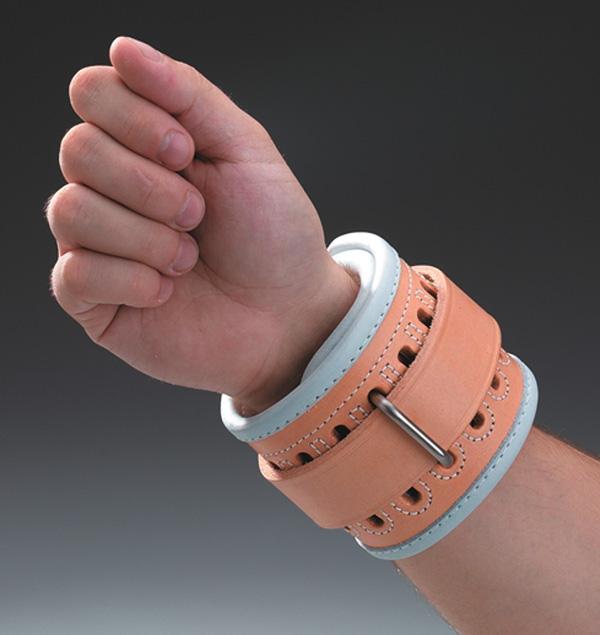
Soft limb restraints are usually made from cotton or foam material, or both ( Fig. 69.3 ). They are single-use devices, which obviates the need for cleaning and sterilization. Soft limb restraints are less rigid than leather limb restraints, which makes them easier to apply. In addition, because they are fastened without the use of a key, soft limb restraints are more easily removed. Soft restraints are typically used for agitated but less combative patients because they are not as secure as leather limb holders.
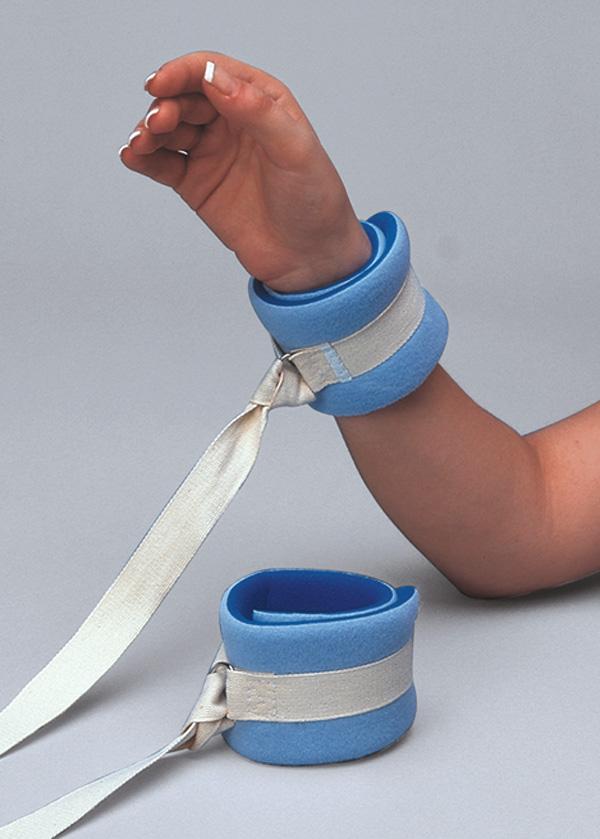
A fifth-point restraint is a belt apparatus used to supplement the use of four limb restraints by holding down the thighs, chest, or pelvis ( Fig. 69.4 ). A fifth-point restraint is used on patients who continue to be at risk for harming themselves despite adequate limb restraint and whose continued combative behavior interferes with diagnostic or therapeutic interventions. When patients are restrained across the thighs, chest, or pelvis, they may not be able to sit up or turn onto their sides, thus placing them at higher risk for aspiration should vomiting occur. Keep the side rails of the stretcher in the upright position at all times and place the belt snugly enough to prevent the patient from slipping under the device and thereby increasing the risk for accidental suffocation. Fifth-point restraints are usually made of synthetic material and are available with both quick-release and key-release locks.
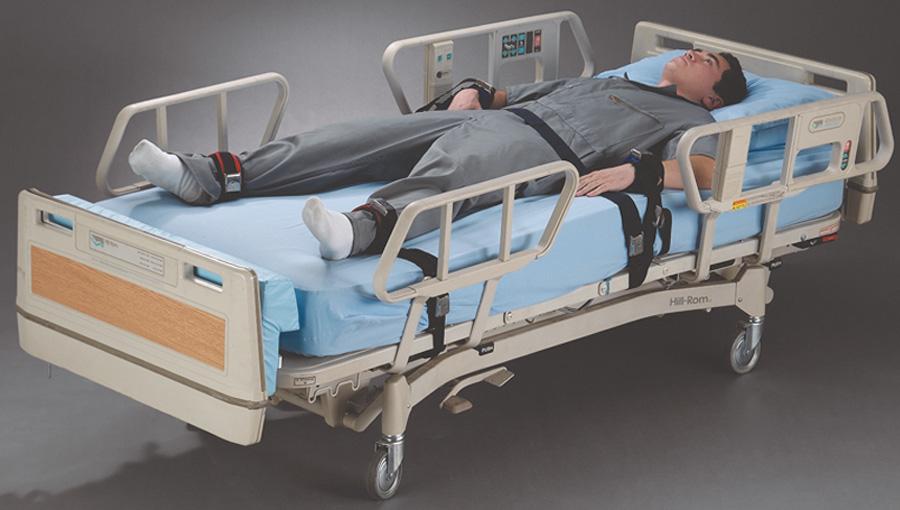
Jackets and vests are generally used on inpatient wards and extended care facilities for the prevention of falls; they have little utility in the ED ( Fig. 69.5 ). Moreover, these products have been implicated in a number of restraint-associated deaths secondary to choking and suffocation. The use of restraint jackets and vests in the ED is not recommended.
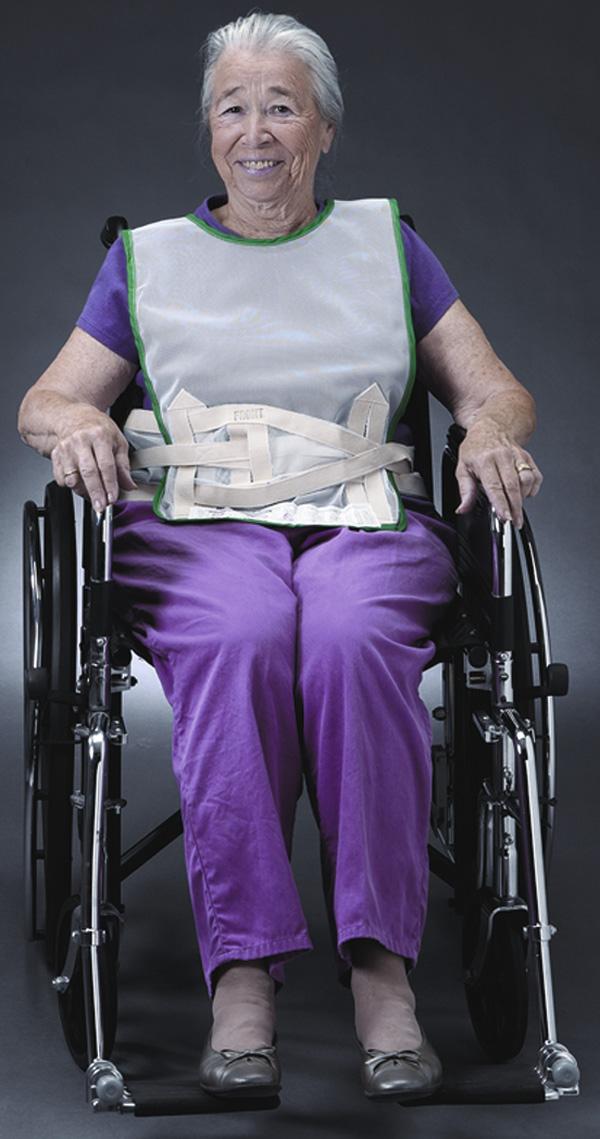
Hobble leg restraints limit movement by securing the patient's ankles with connecting locking cuffs ( Fig. 69.6 ). Hobble leg restraints are commonly used by law enforcement agencies because they impede running and kicking, which makes them an effective method of transporting potentially violent patients and those who pose a risk for flight. Hobble leg restraints are seldom used in the ED, but their use by law enforcement agencies and prison authorities means that most emergency clinicians will encounter patients placed in these devices. The combination of prone positioning, hobble leg restraints, and binding a patient's hands behind the back, commonly referred to as hog-tying , was a common method of restraining prisoners and violent psychiatric patients ( Fig. 69.7 ). However, this practice is no longer widely used because of the risk for suffocation (see later section on Positional Asphyxia ).
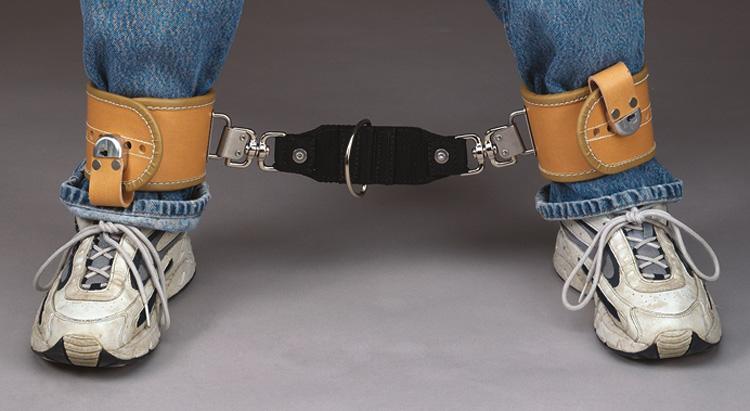
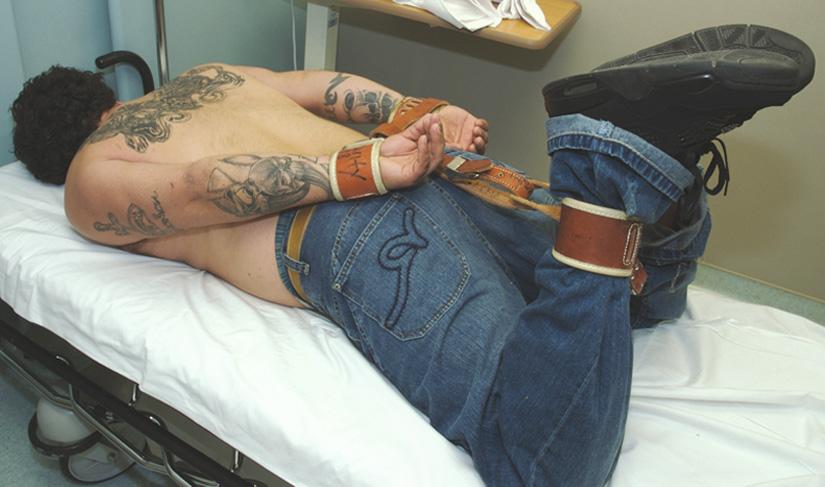
Use limb restraints to prevent agitated, combative, or violent patients from harming themselves or others. Frequently, the use of restraints can be delayed while verbal de-escalation techniques are attempted (see earlier section on De-escalation Techniques ). However, if a patient is deemed an immediate threat to himself/herself or others, restrain him/her without delay. Patients with altered mental status may require limb restraints so that diagnostic testing can be completed or appropriate treatment rendered, or both. Use limb restraints also to prevent patients from interfering with devices, such as endotracheal tubes, cardiac monitors, and indwelling intravenous (IV) lines and catheters.
When appropriate, delay physical restraint in favor of trying verbal de-escalation techniques. Do not place limb restraints on extremities with fractures, open wounds, or acute skin and soft tissue infections. Use caution to avoid ischemia in patients who exhibit tenuous perfusion of extremities, such as those with peripheral vascular disease or previous arterial injury or surgery.
Avoid fifth-point restraint of the abdomen and pelvic region in patients with pelvic fractures, suprapubic tubes, ostomies, and percutaneous feeding tubes. In addition, it is important to note that patients with underlying pulmonary or cardiac disease may not tolerate restraint of their thorax.
Use a minimum of five people, all trained in restraint techniques and patient safety, to restrain the patient if possible ( Fig. 69.8 ). This show of force may help discourage the patient from resisting and is an important part of the restraint process. The individuals making up the restraint team may include clinicians, nurses, technicians, and police or hospital security. When possible, undress and place the patient in a hospital gown before attempting to apply physical restraint. When this is not practical, restrain the patient, but promptly search for weapons and potentially harmful belongings. Confiscate these items and account for them in accordance with institutional policies.

Always restrain patients in the supine rather than the prone position because the prone position increases the risk for suffocation. Assign one person to hold each limb firmly against the stretcher by applying direct pressure proximal to the elbows and knees. The fifth member of the team places restraints around the wrists and ankles ( Fig. 69.9 ). Control above the elbows and knees reduces the risk for injury to these joints and concentrates force closer to the patient's center of gravity for better control.
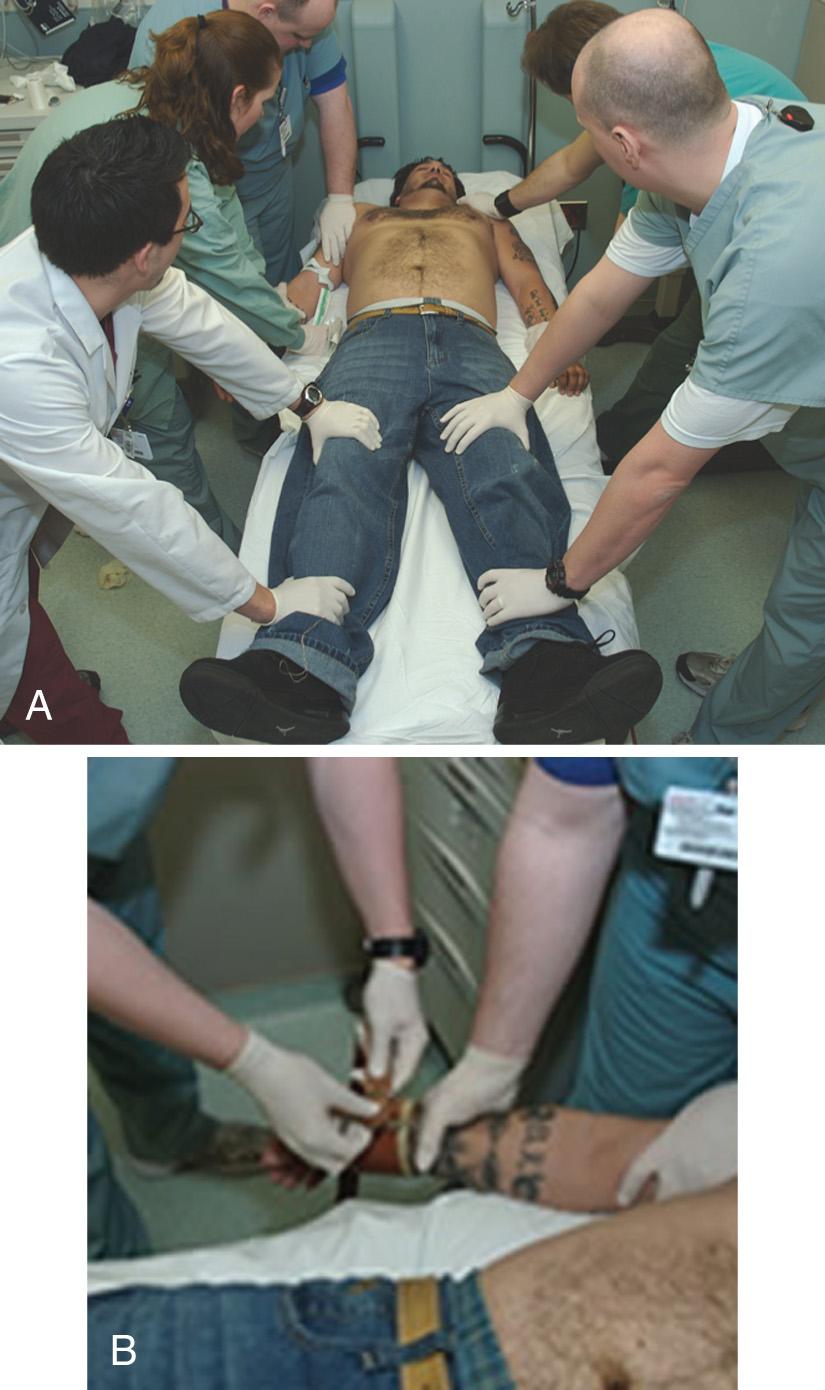
Apply the limb holders snugly enough to control movement and prevent escape, but not so tight that they cause pain or impair circulation. If necessary, place a fifth-point restraint across the patient's thighs, pelvis, or chest to further limit motion. Place a surgical mask temporarily over the patient's mouth to prevent the patient from spitting at members of the restraint team or ED staff. If leather restraints are used, keep a restraint key readily available in the event that the restraints need to be removed urgently.
If four-point ( ) rather than five-point restraints are applied (i.e., use of extremity restraints only), consider placing one arm up alongside the head and the opposite arm down along the side of the body. In this position, it is less likely the patient will be able to overturn the stretcher.
Once the patient has been safely restrained, frequently assess pulses, capillary refill, skin color and temperature, and motor and sensory function. Reevaluate frequently in accordance with your institution's policies and procedures because this is key to preventing complications. In general, restraints should have well-defined time limits and should be removed as soon as the patient's condition has changed sufficiently that the patient is no longer a threat to self or others. For further details regarding rules, regulations, and recommendations for restraint procedures and patient assessment, the reader is referred to the TJC website at https://www.jointcommission.org .
For some patients, placement in physical restraints is so emotionally disturbing that it actually increases agitation and combative behavior. Patients who continue to struggle despite restraints are at risk for a number of potentially serious adverse events, including skin damage, ischemia, metabolic acidosis, rhabdomyolysis, hyperthermia, and even death (see later section on Other Complications ). In these patients, the addition of chemical sedation is highly recommended (see later section on Chemical Restraint ). In contrast, the use of extremity restraints alone is often effective in an alcohol-intoxicated patient because the natural progression of alcohol intoxication is sedation and sleep. Intoxicated patients may benefit from a brief period of observation before a decision is made to administer chemical sedation. Most of these patients will fall asleep, thereby obviating the need for sedation and the accompanying risks.
Restraints may cause skin irritation or breakdown. Risk factors include restraints that are too tight and those that have been left on for prolonged periods. Leather restraints are more likely than soft restraints to cause skin damage, particularly in patients who continue to struggle despite being placed in restraints. To help prevent skin complications, use soft restraints whenever possible, avoid overly tight restraints, limit restraint time, and reevaluate the patient frequently. In addition, use chemical restraint judiciously to help avoid skin damage in patients who continue to struggle. It is important to not ignore a patient's complaints of restraint pain without first evaluating the possibility of an adverse event.
Become a Clinical Tree membership for Full access and enjoy Unlimited articles
If you are a member. Log in here